or Build Your Own Stonehenge
or Build Your Own Stonehenge
Introduction
Sunrise and sunset positions move around the horizon each year. They go from a northernmost position on the summer solstice, move south to cross an east-west line on the equinoxes and continue south to a southernmost position at winter solstice. The solstice sunrises can be used to anchor a calendar to the seasons of the year. The angle between the solstice sunrises make with the east-west equinox sunrise line depends on the latitude of the observer. Thus the geometry of an observatory with sightlines that point to these sunrises will be different at different latitudes. The rising points of the full moon make a more complicated pattern than that of the sun.
Sunrise sunset swiftly flow the days
To Do and Notice
Observe sunrises and sunset during the year. Notice that in the winter the sun rises to the south of an east-west line and in the summer the sun rises to the north of an east-west line.
On the equinoxes the sun rises due east and sets due west. Equinoxes are within a day of March 21 and September 21.
The most northerly sunrise occurs on the winter
solstice, about December 21,
The most southerly sunrise occurs on the summer solstice, about June
21.
Perhaps some of the streets in your neighborhood are aligned in an east-west direction.
What's Going On?
The axis of rotation of the earth is tipped 23.5 degrees with respect to a perpendicular line to its orbital plane.
Use a glowing 40 watt lightbulb to represent the sun and an earth globe with its axis tipped by 23.5 degrees to model the earth's motion around the sun each year and its daily rotation.
At all latitudes on the equinoxes the sun rises
due east. It sets due west.
(The earth's axis will be tipped in a plane perpendicular to the
sun-earth line.)
At the equator on the winter solstice the sun rises and sets 23.5 degrees south of the east-west line. On the summer solstice it sets 23.5 degrees north of the east-west line.
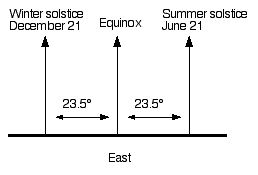
At other latitudes the angle between east and the position of sunrise is greater than 23.5 degrees. For example at San Francisco with a latitude near 38 °N the sun rises 30 degrees south of east on the winter solstice.

There is an equation to calculate, D, the angle from east to the solstice sunrise.
You can click Here to go to a derivation of this equation using paper plates.
If the angle of inclination of the earth's axis is i = 23.5° and the latitude is L, then
Check this out, at the equator L = 0 and cos(0) = 1 so the angle from the solstice sunrise to east is 23.5 degrees.
At the pole L = 90 and cos (90) = 0 so the equation is undefined as it should b.
Why?
Because the sun does not rise and set on the summer or winter solstices at either pole.
Click here if you would like to see a paper plate cut-out derivation of this equation.
To Do and Notice
Find the latitude of your school, or of some ancient culture.
For example a school in San Francisco has a latitude of L = 38 degrees.
Find the angle between east and sunrise on the summer and winter solstice.
From the above equation, we find that at L = 38, D
= 30 degrees from east,
and the angle between summer and winter solstice sunrises is 60
degrees.
Design a structure with angles incorporated into the structure that point to solstice sunrises and sunsets in your chosen location
For example at Latitude 56 degrees the sun rises 45 degrees north of east on summer solstice and 45 degrees south of east on winter solstice, this means that two lines pointing toward the solstices make a 90 degree angle at this latitude. A square structure could have a door in one wall facing the winter solstice sunrise and a window on an adjacent wall facing the summer solstice sunrise.

The teachers in San Francisco designed several structures. One was a hexagon where one face points toward equinox sunrises, one toward summer solstice sunrise, one toward winter solstice sunrise, one toward summer solstice sunset, and the last toward winter solstice sunset. Another teacher made a star of David.
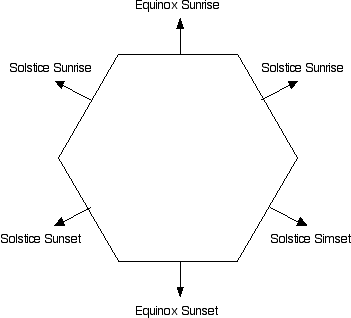
The Moon
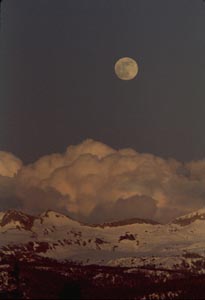
All the major moons in the solar system orbit above the equators of their parent planet except for the earth's moon.
When you look at the night sky, the sun, the planets, and the moon move across the sky in a path known as the ecliptic. The ecliptic is the plane of the earth's orbit around the sun.
The full moon is on the opposite side of the earth from the sun.
Taken together the above two observations mean that in the winter when the sun is low in the sky at noon, the full moon is high in the sky at midnight.
The earth's moon does not orbit exactly in the plane of the ecliptic but is in a plane tilted 5.1 degrees from the ecliptic.
The direction of the tilt of the moon's orbital plane goes through a complete cycle every 18.6 years. This means that the full moon rise position for the full moon nearest the winter solstice can be 5.1 degrees further from east than the summer solstice sunrise position or 5.1 degrees less from east than the summer solstice sunrise position. These maximum positions of the rising moon are called "Lunar Standstills."
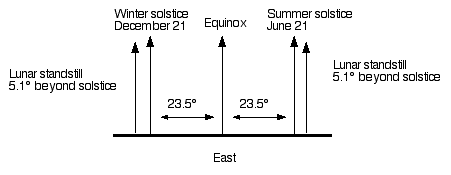
Viewed from the equator the maximum angle from east of the lunar standstill is 28.6°.
In San Francisco where the solstice sunrises are 30 degrees north and south of east. This means that the full moon will rise on the winter solstice 36 degrees south of east once in every 18.6 years. It will rise 24 degrees south of east once every 18.6 year cycle.
Choose a culture or a latitude and design a structure that has walls oriented in directions that point to the positions of the sun or the moon at solstice or equinox.
So What? Stonehenge
For example at the latitude of Stonehenge, 51°N the winter solstice sun rises 40 degrees north of east. The summer full moon rise nearest solstice will be 50 degrees north of east. Similarly the winter full moon rise nearest solstice can be 50 degrees south of north. A structure built to point at the winter solstice sunrise and the summer moon stand still would have two directions differing by 90 degrees! It has been suggested that Stonehenge was built at the precise latitude to allow a rectangular construction.
So What?
Earthworks of the Hopewell Culture
The culture known as the mound builders of Ohio built many giant earthworks between 200 BC and 500 AD. Two of these earthworks were octagons connected to a circle. One of these is shown in the 1848 map below. The circle is 3000 feet in diameter, about a kilometer across.
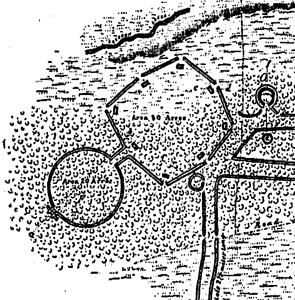
A line from the center of the circle through the center of the octagon of the structure points 52 degrees east of north. The latitude of the site is 40.0 degrees. Can you find any solar or lunar alignments?
Reading from the Ohio Historical Society
Click here to see other archeoastronomy sites with alignments and their latitudes:
Math Root
Solstice Calculator
To calculate the angle, D, between the east-west line and solstice sunrise or sunset at latitude L use the equation
Sin(D) = Sin(i)/Cos(L)
where
sin (i) = sin (23.5) = 0.399
use the table below,
a calculator,
or use google's calculator
(for example for L = 45 type "arcsin(sin(23.5 degrees)/cos(45
degrees)) in degrees")
L Angle degrees Cosine (L) arcsin 5 0.996 23.6 degrees 10 0.985 23.9 15 0.966 24.4 20 0.940 25.1 25 0.906 26.1 30 0.866 27.4 35 0.819 29.2 40 0.766 31.4 45 0.707 34.4 50 0.643 38.4 55 0.574 44.0 60 0.5 52.9 65 0.423 70.6
(Sin(i) / Cos(L))
Lunar Standstill Calculator
To calculate the angle, M, between the east-west line and lunar standstill moonrise or moonset at a latitude L use the equation
Sin(M) = Sin(A)/Cos(L)
where
A = i + 5.1° and sin (A) = sin (28.6) = 0.477
L Angle degrees Cosine (L) arcsin 5 0.996 28.7 degrees 10 0.985 29.1 15 0.966 29.7 20 0.940 30.6 25 0.906 31.9 30 0.866 33.6 35 0.819 35.8 40 0.766 38.7 45 0.707 42.6 50 0.643 48.1 55 0.574 56.6 60 0.5 73.2 65 0.423
(Sin(A) / Cos(L))
You can use the following polar plot to cut out the angles for your chosen latitude.

References
Website on sunrise azimuth
http://www.bedford.k12.ny.us/flhs/science/riseazimuth.html
For Stonehenge, the original book Stonehenge Decoded, is still the best reference.
|
Scientific Explorations with Paul Doherty |
|
14 May 2005 |